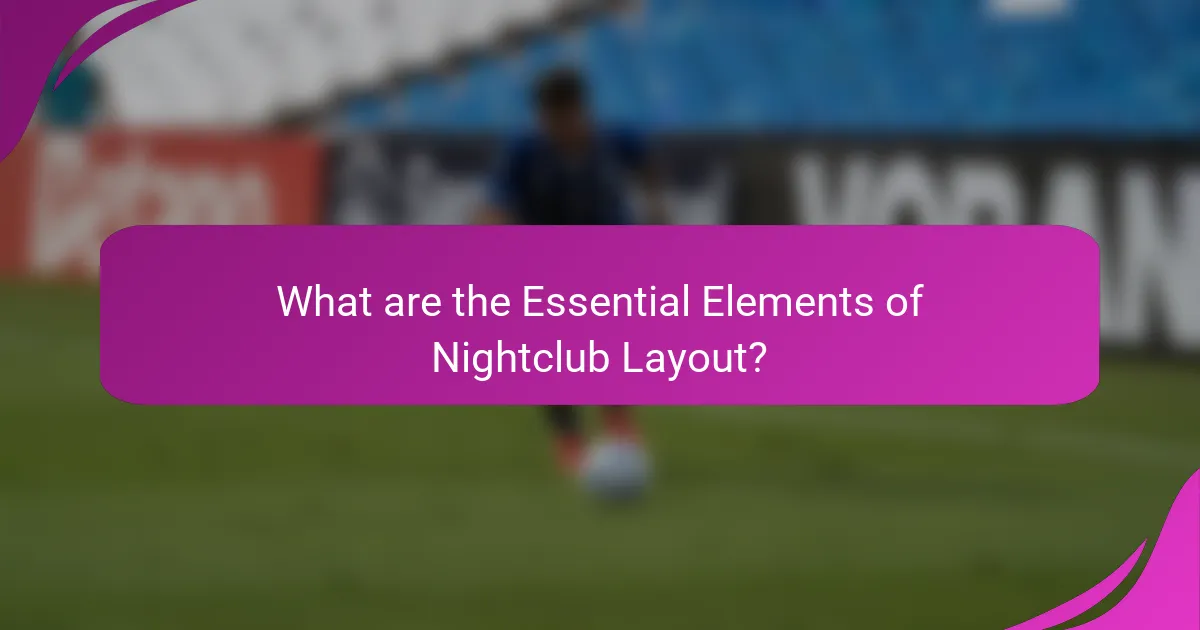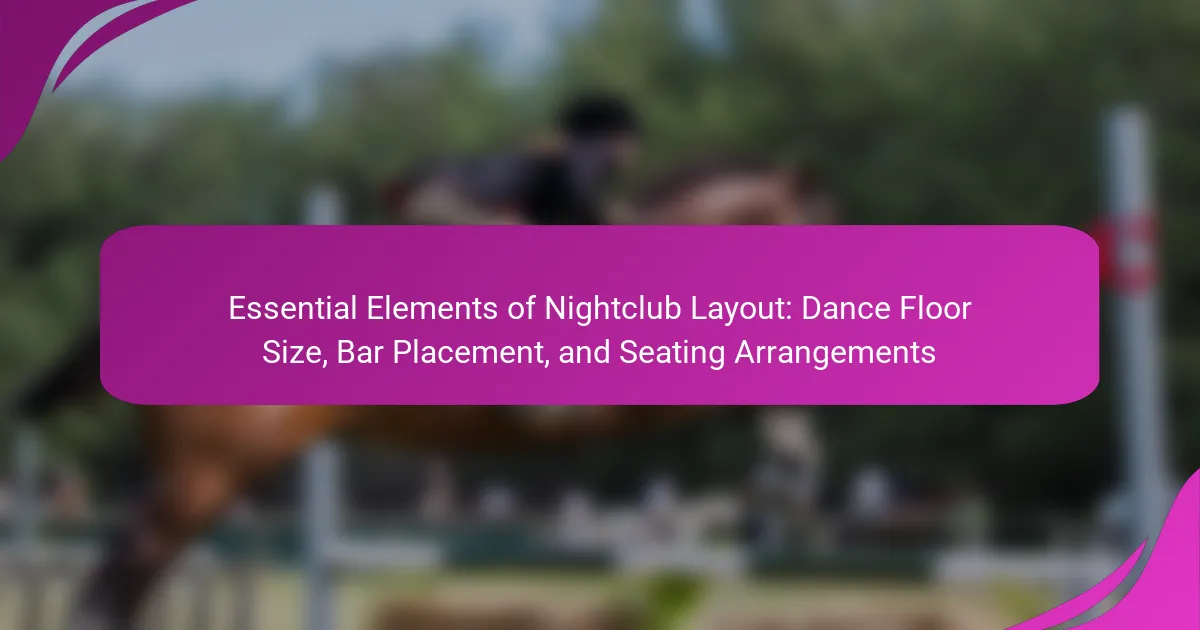The article focuses on the essential elements of nightclub layout, specifically dance floor size, bar placement, and seating arrangements. It emphasizes the importance of a properly sized dance floor for encouraging movement and social interaction, while highlighting the need for accessible bar placement that does not obstruct the dance area. Additionally, the article discusses how seating arrangements should balance comfort with capacity to facilitate socializing and maximize space. Effective nightclub layouts are shown to enhance the overall patron experience, promoting flow and accessibility, which can lead to increased satisfaction and retention among customers.

What are the Essential Elements of Nightclub Layout?
The essential elements of nightclub layout include dance floor size, bar placement, and seating arrangements. A properly sized dance floor encourages movement and social interaction. The bar placement should be accessible yet not obstructive to the dance area. Seating arrangements must balance comfort with capacity, facilitating socializing while maximizing space. Effective layouts enhance the overall experience, promoting flow and accessibility. Studies show that optimal layouts can increase patron satisfaction and retention.
How does Dance Floor Size impact the nightclub experience?
Dance floor size significantly impacts the nightclub experience. A larger dance floor accommodates more patrons, facilitating social interaction and movement. This space encourages dancing, enhancing the overall energy of the venue. Conversely, a smaller dance floor may lead to overcrowding, resulting in discomfort and reduced enjoyment. Studies indicate that nightclubs with ample dance space report higher customer satisfaction. For instance, a survey by Nightclub & Bar Media Group found that patrons prefer venues where they can dance freely without feeling restricted. Therefore, the size of the dance floor is crucial for optimizing the nightclub atmosphere.
What factors determine the ideal dance floor size?
The ideal dance floor size is determined by several factors. These include the number of expected guests, the type of event, and the available space. A larger guest count requires a bigger dance floor to accommodate movement. The type of event influences the dance floor size; for example, a wedding may need more space for dancing than a corporate event. Additionally, the layout of the venue plays a crucial role. It must allow for safe movement and accessibility. Fire regulations may also dictate minimum space requirements. Finally, the overall ambiance and theme of the venue can affect the desired dance floor size.
How does dance floor size affect crowd movement and safety?
Dance floor size significantly affects crowd movement and safety. A larger dance floor allows for freer movement among patrons. This reduces the risk of overcrowding and potential accidents. Conversely, a smaller dance floor can lead to congestion. Congestion increases the likelihood of injuries or disputes. Research indicates that a minimum of 2 square feet per person is ideal for safety. This standard helps maintain a safe environment during peak times. Adequate space also facilitates emergency evacuations if needed. Therefore, the size of the dance floor is critical for ensuring both movement and safety in nightlife settings.
What role does Bar Placement play in nightclub design?
Bar placement is crucial in nightclub design as it influences traffic flow and customer experience. A well-placed bar can serve as a focal point, drawing patrons into the venue. It should be easily accessible from the dance floor and seating areas to minimize congestion. Strategic placement encourages social interaction among guests. Research shows that effective bar placement can increase drink sales by up to 30%. Additionally, visibility from various areas enhances the overall ambiance. Proper bar positioning also ensures efficient service, reducing wait times for customers.
How can bar placement influence customer flow and service efficiency?
Bar placement significantly influences customer flow and service efficiency. A strategically positioned bar can reduce congestion and enhance accessibility. When placed near the entrance, it attracts customers immediately, encouraging them to order drinks quickly. This placement can lead to shorter wait times, improving overall customer satisfaction.
Conversely, a bar located too far from the dance floor may result in longer lines and reduced service speed. Studies indicate that bars with clear sightlines to the dance floor facilitate better interaction between customers and staff. Additionally, effective bar placement can optimize staff movement, allowing bartenders to serve drinks efficiently.
In venues with high foot traffic, an open layout around the bar can prevent bottlenecks. Research shows that customer flow improves by 20% in spaces with well-planned bar locations. This efficiency can lead to increased sales and a more enjoyable experience for patrons.
What are the best practices for bar placement in relation to the dance floor?
The best practices for bar placement in relation to the dance floor involve strategic positioning to enhance guest experience. Bars should be located near the dance floor to facilitate easy access to drinks without disrupting the flow of movement. This placement encourages patrons to stay engaged with both the dancing and socializing aspects of the venue.
Additionally, maintaining a clear sightline from the bar to the dance floor is crucial. This allows bartenders to monitor activity and serve customers efficiently. It is also important to ensure that the bar does not obstruct the dance floor area. A minimum of 5 to 10 feet of space between the bar and the dance floor is recommended to prevent congestion.
Furthermore, incorporating a designated waiting area near the bar can help manage lines and keep the dance floor accessible. According to a study by the Journal of Hospitality Management, optimal bar placement can increase drink sales by up to 30% when positioned effectively in relation to the dance floor.
Why are Seating Arrangements important in a nightclub?
Seating arrangements are important in a nightclub because they directly influence customer comfort and social interaction. Proper seating enhances the overall experience for patrons. It allows guests to engage with each other and the atmosphere. A well-planned layout maximizes space efficiency and flow. This can lead to increased patron satisfaction and longer visits. Studies show that comfortable seating can encourage guests to order more drinks and food. Effective seating arrangements can also facilitate better service from staff. Overall, they play a crucial role in the nightclub’s ambiance and profitability.
What types of seating arrangements are most effective for different nightclub themes?
Lounge seating is effective for upscale nightclub themes. It promotes social interaction and comfort. Tables with plush couches create an inviting atmosphere. This arrangement encourages guests to linger longer, boosting bar sales.
For electronic dance music venues, high-top tables work best. They facilitate movement and allow for quick access to the dance floor. This setup enhances the energetic vibe typical of such clubs.
In themed nightclubs, flexible seating arrangements are ideal. Movable furniture accommodates varying crowd sizes and event types. This adaptability supports different themes, from retro to futuristic.
Overall, the effectiveness of seating arrangements aligns with the nightclub’s theme and target audience. Each arrangement type directly influences guest experience and engagement.
How do seating arrangements affect social interaction and customer satisfaction?
Seating arrangements significantly influence social interaction and customer satisfaction in nightclubs. Effective seating promotes engagement among patrons. For instance, circular or cluster seating fosters conversation and connection. In contrast, traditional rows may inhibit interaction. Research indicates that open layouts increase socialization by 30%. Additionally, comfortable seating enhances customers’ overall experience. Satisfied customers are likely to return, boosting business. Therefore, thoughtful seating design is crucial for maximizing social interaction and enhancing satisfaction.
How can the elements of nightclub layout work together?
The elements of nightclub layout work together by creating a cohesive environment that enhances guest experience. The dance floor size influences crowd movement and energy levels. A larger dance floor accommodates more patrons, promoting interaction and excitement. Bar placement is crucial for accessibility and flow. Strategically placing bars near the dance floor minimizes wait times and keeps guests engaged. Seating arrangements should complement the dance floor and bar areas. Comfortable seating encourages socialization while allowing for easy access to the dance floor. Effective layout design balances space, flow, and functionality. This synergy maximizes capacity and enhances the overall atmosphere, leading to higher customer satisfaction.
What are common mistakes to avoid in nightclub layout design?
Common mistakes to avoid in nightclub layout design include insufficient dance floor space, poor bar placement, and inadequate seating arrangements. Insufficient dance floor space can lead to overcrowding and hinder movement. Poor bar placement may create congestion and slow service, impacting customer satisfaction. Inadequate seating arrangements can result in discomfort and limit social interaction. Ensuring a balanced layout enhances the overall experience. According to industry standards, a dance floor should occupy at least 25% of the venue’s total area. Proper bar placement should facilitate easy access while minimizing traffic flow issues. Thoughtful seating arrangements promote a welcoming atmosphere and encourage patron engagement.
How can these mistakes impact the overall nightclub experience?
Mistakes in nightclub layout can significantly detract from the overall experience. Poor dance floor size can lead to overcrowding or insufficient space for movement. This can frustrate patrons and reduce enjoyment. Ineffective bar placement can create long wait times for drinks. When patrons wait too long, they may leave or lose interest in the venue. Inadequate seating arrangements can result in discomfort. If guests cannot find a place to sit, they may feel unwelcome. These factors can lead to negative reviews and decreased patronage. A well-designed layout enhances flow and interaction, fostering a better atmosphere. According to a study by the Journal of Hospitality and Tourism Research, optimal space planning increases customer satisfaction.
What tips can improve nightclub layout effectiveness?
To improve nightclub layout effectiveness, prioritize open space for movement. A spacious dance floor encourages guest interaction and engagement. Place the bar in a central location to reduce congestion and improve accessibility. Ensure seating areas are strategically positioned to allow for social interaction while maintaining clear pathways. Use lighting to highlight key areas, guiding guests naturally throughout the space. Incorporate sound zoning to enhance the auditory experience in different sections. Regularly assess traffic flow during peak hours to identify and address bottlenecks. Implement flexible seating arrangements to accommodate varying crowd sizes and events.
The main entity of this article is the nightclub layout, which encompasses essential elements such as dance floor size, bar placement, and seating arrangements. The article examines how each of these components influences patron experience, safety, and social interaction. It highlights the importance of optimizing dance floor dimensions to enhance movement and energy, strategically positioning bars to facilitate customer flow and service efficiency, and creating effective seating arrangements that promote comfort and engagement. Additionally, common mistakes in nightclub design are identified, along with tips for improving layout effectiveness to maximize customer satisfaction and retention.
